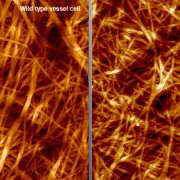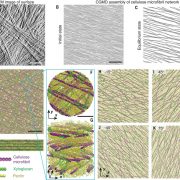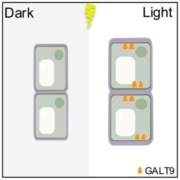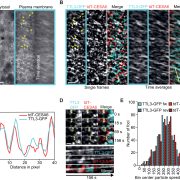RALF4 prevents pollen tubes from growing crazy
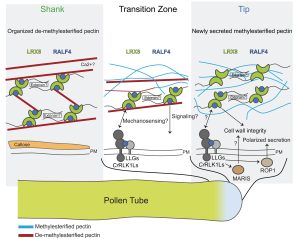 Pollen tubes are characterized by extremely fast elongation growth. Previously, small peptides known as RALFs (RAPID ALKALINIZATION FACTORs) were identified as signaling peptides, some with a role in pollen tube growth; for instance, RALF4/19 are important in maintaining the cell wall integrity of pollen tubes. RALF peptides bind to a membrane-integral protein complex consisting of LLGs [LORELEI-like GLYCOLPHOSPHATIDYLINOSITOL (GPI)-ANCHORED PROTEINS] and CrRLK1Ls (Catharanthus roseus RLK1-like receptor kinases). In addition, RALF peptides also bind to cell wall-anchored LRX (LEUCINE-RICH REPEAT EXTENSIN) proteins. When RALF4 binds to LRX8, it exposes an alkaline surface patch hypothesized to interact with negatively charged cell wall polysaccharides like pectin. In a recent study, Moussu et al. used the Arabidopsis pollen tube to explore the LRX8-RALF4 complex’s role in cell wall patterning. Using biochemical assays, they discovered that the LRX8-RALF4 complex directly binds to oligogalacturonans (OGs, a type of pectin). Notably, neither RALF4 nor LRX8 alone could bind to OGs independently. This interaction is specific to demethylated pectins, found predominantly in the pollen tube’s shank. Super-resolution imaging with immunolabeling revealed that LRX8 and RALF4 not only colocalize but also associate with pectin, creating a reticulated pattern along the pollen tube cell wall. Surprisingly, RALF4 is present along the pollen tube cell wall as an integral component colocalizing with LRX8. In addition, they found that mutations of the exposed alkaline surface of RALF4 lead to abnormal cell wall patterning, increased pollen tube growth rates, and premature bursting. Collectively, these discoveries highlight the critical role of the LRX8-RALF4-pectin association in the assembly and patterning of the pollen tube cell wall. (Summary by Xiaohui Li @Xiao_hui_Li) Science 10.1126/science.adi4720. For an extended analysis of this study’s background and future directions, and to see a wonderful image of pectin network in an Arabidopsis pollen tube, I recommend to read the excellent perspective article from Debra Mohnen in Science (10.1126/science.adl1198).
Pollen tubes are characterized by extremely fast elongation growth. Previously, small peptides known as RALFs (RAPID ALKALINIZATION FACTORs) were identified as signaling peptides, some with a role in pollen tube growth; for instance, RALF4/19 are important in maintaining the cell wall integrity of pollen tubes. RALF peptides bind to a membrane-integral protein complex consisting of LLGs [LORELEI-like GLYCOLPHOSPHATIDYLINOSITOL (GPI)-ANCHORED PROTEINS] and CrRLK1Ls (Catharanthus roseus RLK1-like receptor kinases). In addition, RALF peptides also bind to cell wall-anchored LRX (LEUCINE-RICH REPEAT EXTENSIN) proteins. When RALF4 binds to LRX8, it exposes an alkaline surface patch hypothesized to interact with negatively charged cell wall polysaccharides like pectin. In a recent study, Moussu et al. used the Arabidopsis pollen tube to explore the LRX8-RALF4 complex’s role in cell wall patterning. Using biochemical assays, they discovered that the LRX8-RALF4 complex directly binds to oligogalacturonans (OGs, a type of pectin). Notably, neither RALF4 nor LRX8 alone could bind to OGs independently. This interaction is specific to demethylated pectins, found predominantly in the pollen tube’s shank. Super-resolution imaging with immunolabeling revealed that LRX8 and RALF4 not only colocalize but also associate with pectin, creating a reticulated pattern along the pollen tube cell wall. Surprisingly, RALF4 is present along the pollen tube cell wall as an integral component colocalizing with LRX8. In addition, they found that mutations of the exposed alkaline surface of RALF4 lead to abnormal cell wall patterning, increased pollen tube growth rates, and premature bursting. Collectively, these discoveries highlight the critical role of the LRX8-RALF4-pectin association in the assembly and patterning of the pollen tube cell wall. (Summary by Xiaohui Li @Xiao_hui_Li) Science 10.1126/science.adi4720. For an extended analysis of this study’s background and future directions, and to see a wonderful image of pectin network in an Arabidopsis pollen tube, I recommend to read the excellent perspective article from Debra Mohnen in Science (10.1126/science.adl1198).



